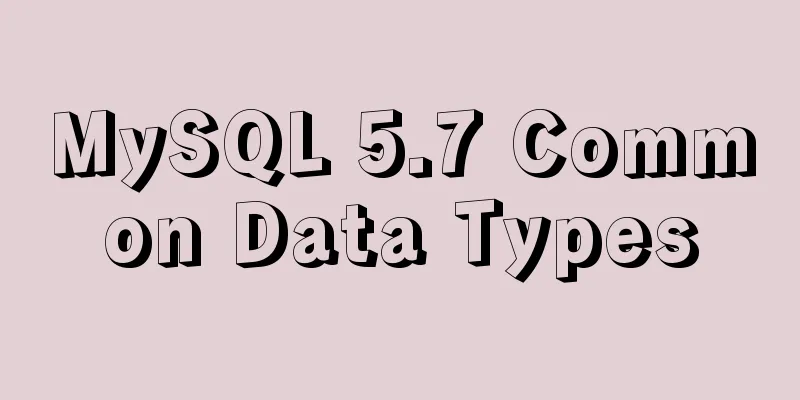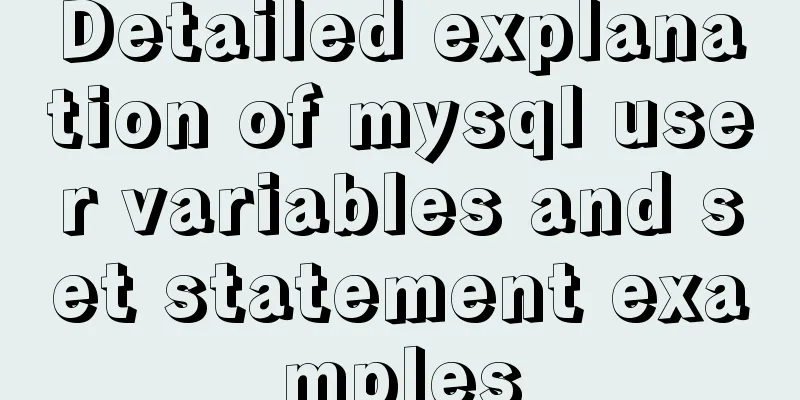MySQL 5.7 Common Data Types

|
——Notes from "MySQL in Simple Terms (Second Edition)" Numeric Types
Integer Types For integer types, MySQL supports specifying the display width by using Example: --Create table t1 with two fields, id1 and id2, and specify the value widths as int and int(5) respectively mysql> create table t1 (id1 int,id2 int(5)); mysql> desc t1;
--Insert the value 1 into both id1 and id2 mysql> insert into t1 values (1,1); mysql> select * from t1;
--Add zerofill parameters to the id1 and id2 fields respectivelymysql> alter table t1 modify id1 int zerofill; mysql> alter table t1 modify id2 int(5) zerofill;
After setting the width limit, if you insert a value larger than the width limit, it will not have any impact on the inserted data, and the data will still be saved according to the type's book precision. At this point, the width format is actually meaningless and no "0" characters will be filled on the left. --Insert 1 into id1 and 12345678 into id2 of table t1 mysql> insert into t1 values(1,12345678); mysql> select * from t1;
All integer types have an optional attribute In addition, the integer type also has a unique Any column you want to use AUTO_INCREMENT with should be defined as NOT NULL and UNIQUE. Floating-point typesFor the representation of decimals, MySQL divides them into two types: floating point numbers and fixed point numbers. Floating-point numbers include float (single precision) and double (double precision), while fixed-point numbers only have decimal. Fixed-point numbers are stored in MySQL as strings. They are more precise than floating-point numbers and are suitable for representing high-precision data such as currency. Both floating-point numbers and fixed-point numbers can be represented by adding "(M,D)" after the type name. "(M,D)" means that the value is displayed with a total of M digits and D decimal digits. When MySQL saves floating-point values, it rounds off excess digits. So if you insert 123.006 into float(5,3), the stored value is 123.01. When the precision of float and double is not specified, the default is determined by the actual hardware and operating system; when decimal is not specified, the default integer digits are 10 and the decimal digits are 0. Example: --Create table tf, set fields id1, id2, id3 to float(5,2), double(5,2), decimal(5,2) respectively mysql> create table tf( id1 float(5,2),id2 double(5,2),id3 decimal(5,2));
--Insert data into the three fields in the table 1.23 mysql> insert into tf values(1.23,1.23,1.23);
--Insert data 1234.005 into the table respectively mysql> insert into tf values(1234.005,1234.005,1234.005);
--Insert data 123.005 into the table respectively mysql> insert into tf values(123.005,123.005,123.005);
--Insert data 123.006, 123.006, 123.004 into the table respectively mysql> insert into tf values(123.006,123.006,123.004);
--Remove the precision of the table tf field and reinsert 1.23 mysql> alter table tf modify id1 float; mysql> alter table tf modify id2 double; mysql> alter table tf modify id3 decimal; mysql> insert into tf values(1.23,1.23,1.23); mysql> desc tf;
--Insert 1.234567123321,1.234567123321123321,1.23234233 into the table mysql> insert into tf values(1.234567123321,1.234567123321123321,1.23234233);
Bit Type For the BIT type, it is used to store bit field values. BIT(M) can be used to store multi-bit binary numbers. The range of M is from 1 to 64. If not written, the default is 1 bit. If you use the SELECT command directly, you will not see the query results. You need to use Example: --Create table tb, define field id1 as bit(1), id2 as bit mysql> create table tb(id1 bit(1),id2 bit);
--Insert 1,1 into tb mysql> insert into tb values(1,1); mysql> select * from tb; mysql> select bin(id1),hex(id2) from tb;
When data is inserted into a bit field, it is first converted to binary. If the number of bits allows, the data is successfully inserted. If the number of bits exceeds the defined number of bits, the data is not inserted.
Time TypeThere are many data types in MySQL that can be used to represent date and time. The following table lists all the date and time types supported in MySQL 5.0. |
| Date and time types | byte | Minimum | Maximum |
|---|---|---|---|
| DATE | 4 | 1000-01-01 | 9999-12-31 |
| DATETIME | 8 | 1000-01-01 00:00:00 | 9999-12-31 23:59:59 |
| TIMESTAMP | 4 | 19700101080001 | Sometime in 2038 |
| TIME | 3 | -838:59:59 | 838:59:59 |
| YEAR | 1 | 1901 | 2155 |
Each time type has a valid range. If it exceeds this range, the system will prompt an error in the default SQLMode and store it with a zero value.
Data Types
--Create table tdt mysql> create table tdt(dt date, dttm datetime, tms timestamp,tm time,yr year);

--Use the now() function to insert the current time into the table mysql> insert into tdt values(now(),now(),now(),now(),now());

--Insert NULL into tms, MySQL will automatically assign the system time mysql> insert into tdt(tms) values(null);

MySQL only assigns the system time to the first TIMESTAMP field in the table. If there are other fields, they are assigned a value of 0.
--Modify table tdt, add tms1 column of TIMESTAMP type, and assign null values to tms and tms1 mysql> alter table tdt add tms1 timestamp; mysql> desc tdt; mysql> insert into tdt(tms,tms1) values(null,null);

An important feature of TIMESTAMP is that it is related to loss. When inserting a date, it will be converted to the local time zone before being stored; when retrieving it from the database, the date needs to be converted to the local time zone before being displayed.
--Create table tdt1, including fields tms, dt mysql> create table tdt1(tms timestamp,dt datetime);

--View the current time zone and insert the system time into table tdt1mysql> show variables like 'time_zone'; mysql> insert into tdt1 values(now(),now());

It can be found that the time zone value is SYSTEM . This value is consistent with the host's time zone by default. Because it is in China, it is actually East 8 (+8:00).
--Change the time zone to East 9th District and check the time in tdt1 againmysql> set time_zone='+9:00';

String Type
MySQL provides a variety of storage types for string data, which vary in different versions. Taking 5.0 as an example, MySQL includes CHAR , VARCHAR , BINARY , VARBINARY , BLOB , TEXT , ENUM and SET .
| Data Types | Description is storage |
|---|---|
| CHAR(M) | M is an integer between 0 and 255 |
| VARCHAR(M) | M is an integer between 0 and 65535, the length of the value + 1 byte |
| TINYBLOB | The allowed length is 0~255 bytes, the value length + 1 byte |
| BLOB | The allowed length is 0~65535 bytes, the value length + 2 bytes |
| MEDIUMBLOB | The allowed length is 0~167772150 bytes, the value length + 3 bytes |
| LONGBLOB | The allowed length is 0 to 4294967295 bytes, the length of the value + 4 bytes |
| TINYTEXT | The allowed length is 0~255 bytes, the value length + 1 byte |
| TEXT | The allowed length is 0~65535 bytes, the value length + 2 bytes |
| MEDIUMTEXT | The allowed length is 0~167772150 bytes, the value length + 3 bytes |
| LONGTEXT | The allowed length is 0 to 4294967295 bytes, the length of the value + 4 bytes |
| VARBINARY(M) | Allows variable-length byte strings of 0 to M bytes, the length of the value + 1 byte |
| BINARY(M) | Fixed-length byte strings of length 0 to M bytes are allowed |
method
CHAR and VARCHAR
The two are very similar and are both used to store shorter strings in MySQL. The main difference between the two is the storage method: the length of a CHAR column is fixed to the length declared when the table is created; while the value in a VARCHAR column is a variable-length string. When searching, CHAR removes trailing spaces, while VARCHAR does not.
--Create table tc, containing two fields ch (char(6)) and vc (varchar(6))
mysql> create table tc (ch char(6),vc varchar(6));
--Insert 'abc' into the ch and vc fields
mysql> insert into tc values('abc ','abc ');
--Query field length mysql> select length(ch),length(vc) from tc; 

BINARY and VARBINARY
Similar to CHAR and VARCHAR, except that they store binary strings.
--Create table tbc, including fields bc (binary(6)), vbc (varbinary(6))
mysql> create table tbc (bc binary(6),vbc varbinary(6));
--Insert data into the table ('a ','a ')
mysql> insert into tbc values('a ','a ');
--View the length of the field value mysql> select length(bc),length(vbc) from tbc; 
When storing BINARY values, MySQL pads the value with 0x00 (zero bytes) to the specified field definition length.
--Use the hex() function to view the data saved in tbcmysql> select length(bc),length(vbc) from tbc;

ENUM Type
The value range of the enumeration type needs to be explicitly specified through enumeration when creating the table. For an enumeration of 1255 members, 1 byte of storage is required; for an enumeration of 25665535 members, 2 bytes of storage are required. A maximum of 65535 members is allowed.
--Create table te, containing field f1 (enum('a','b','c'))
mysql> create table te(f1 enum('a','b','c'));
--Insert several records into the tablemysql> insert into te values('a'),('B'),('3'),(null); 
ENUM is case-insensitive. It also supports inserting data using subscripts (starting from 1, an error will be reported if the subscript is out of bounds). The special value '0' represents a null value.

SET type
SET is very similar to ENUM, and is also a string object that can contain 0 to 64 members. Storage varies depending on the number of members.
A set of 1 to 8 members, occupies 1 byte
A set of 9 to 16 members takes up 2 bytes
A set of 17 to 24 members takes up 3 bytes
A set of 25 to 32 members takes up 4 bytes
A set of 32 to 64 members takes up 8 bytes
Moreover, the SET type can select multiple members at a time.
--Create table ts, including field f1 (set())
mysql> create table ts (f1 set('a','b','c','d'));
mysql> insert into ts values('a,b'),('a,d'),('b,c,d'); 
--Insert data into the table ('a,b,a,c,d,d')
mysql> insert into ts values('a,b,a,c,d,d'); 
The SET type can select any number of elements from the allowed value set for combination, so as long as the input value is within the allowed value combination range, it can be correctly recorded in the SET type column. For values outside the allowed range, an error is reported. Sets with duplicate members will be automatically deduplicated.
This is the end of this article about common data types in MySQL 5.7. For more information about MySQL data types, please search 123WORDPRESS.COM's previous articles or continue to browse the following related articles. I hope you will support 123WORDPRESS.COM in the future!
- Detailed explanation of MySql data type tutorial examples
- MySQL chooses the appropriate data type for id
- MySQL data type selection principles
- Implementation of mysql decimal data type conversion
- Implementation of mysql data type conversion
- Detailed explanation of the usage of MySQL data type DECIMAL
- Detailed explanation of the decimal padding problem of decimal data type in MySQL
- MySQL data type details
<<: Example code for using HTML ul and li tags to display images
>>: CSS to achieve chat bubble effect
Recommend
Summary of uncommon js operation operators
Table of contents 2. Comma operator 3. JavaScript...
Getting started with JavaScript basics
Table of contents 1. Where to write JavaScript 2....
JavaScript Factory Pattern Explained
Table of contents Simple Factory Factory Method S...
5 Ways to Send Emails in Linux Command Line (Recommended)
When you need to create an email in a shell scrip...
How does MySQL ensure data integrity?
The importance of data consistency and integrity ...
CSS clicks on the radio to switch between two image styles and only one of the multiple radios can be checked
We implement a red image style for the clicked bu...
Vue implements tree table
This article example shares the specific code of ...
Example code for implementing beautiful clock animation effects with CSS
I'm looking for a job!!! Advance preparation:...
Grid systems in web design
Formation of the grid system In 1692, the newly c...
Detailed analysis of GUID display issues in Mongodb
Find the problem I recently migrated the storage ...
Nginx sample code for implementing dynamic and static separation
In combination with the scenario in this article,...
MySQL SQL statement to find duplicate data based on one or more fields
SQL finds all duplicate records in a table 1. The...
How to use Linux to calculate the disk space occupied by timed files
Open the scheduled task editor. Cent uses vim to ...
How to install MySQL 8.0 and log in to MySQL on MacOS
Follow the official tutorial, download the instal...
Detailed explanation and summary of the URL for database connection
Detailed explanation and summary of the URL for d...
























